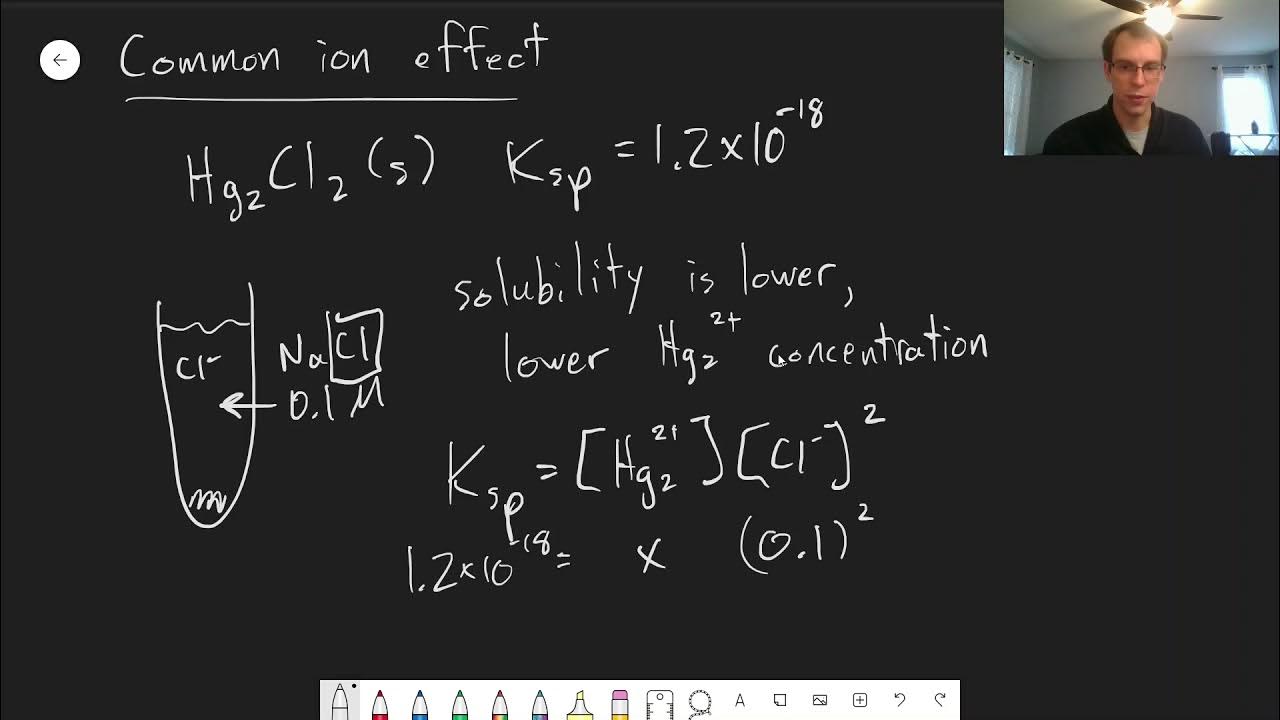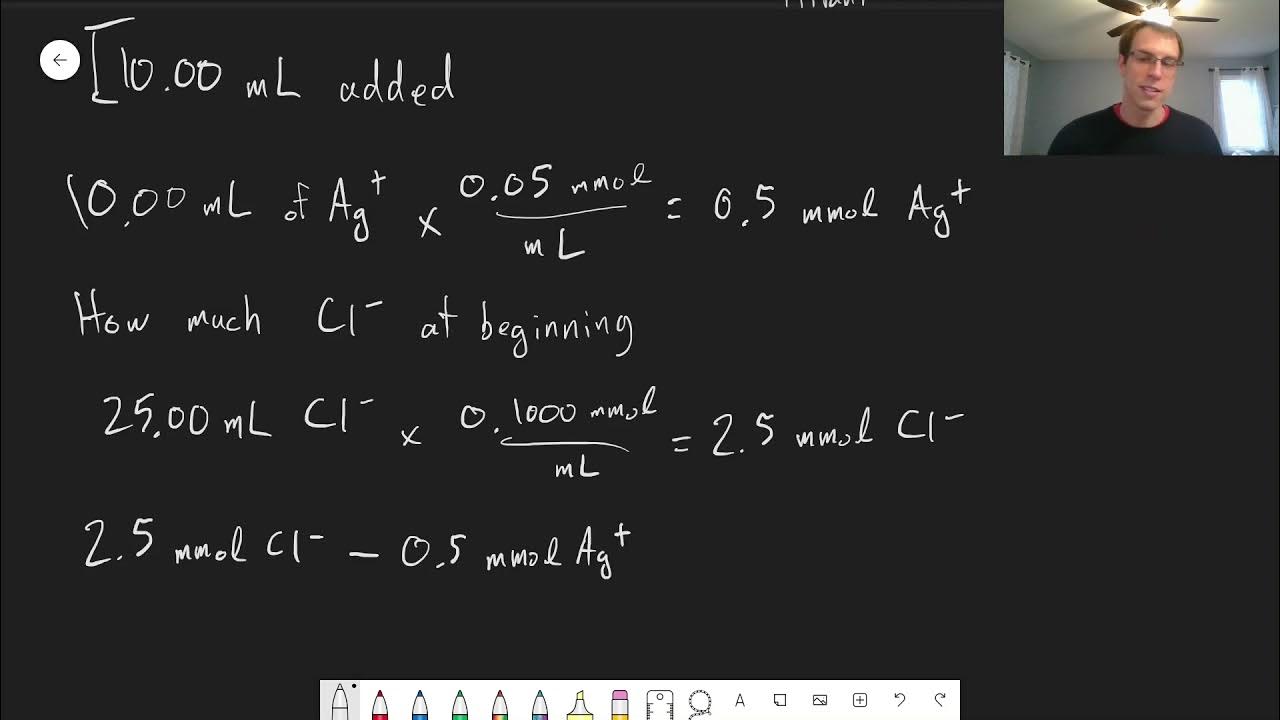Chapter 6: Solubility Product Example | CHM 214 | 055
TLDRThe video script discusses the application of solubility product to calculate the concentrations of mercury and chloride ions in a solution. It explains that at equilibrium, the product of the concentrations of mercury ions (x) and chloride ions (2x) equals 1.2 x 10^-18. By solving the equation, the script demonstrates how to find the concentration of mercury ions (6.7 x 10^-7 M) and subsequently double it to obtain the concentration of chloride ions (1.3 x 10^-6 M). The process highlights the low concentrations and the need for specialized equipment to detect these ions.
Takeaways
- 🧪 The script discusses the use of solubility product to calculate concentrations of ions in a solution.
- 📈 Given a scenario with mercury and chloride ions, the solubility product constant is used to determine their concentrations.
- 🌡️ The system is assumed to be at equilibrium, a crucial前提 for applying the solubility product constant.
- 🔍 The stoichiometric ratio of mercury to chloride ions is 1:2, as per the chemical equation provided.
- 📝 The calculation involves setting up an equation where the concentration of mercury ions (x) times the concentration of chloride ions (2x) squared equals the solubility product constant (1.2 × 10^-18).
- 🧮 Solving the equation for x yields the concentration of mercury ions, which is found to be 6.7 × 10^-7 M (molarity).
- 🔎 The concentration of chloride ions is twice that of mercury ions, resulting in a concentration of 1.3 × 10^-6 M.
- 💡 The use of molarity as the concentration unit is emphasized due to the nature of equilibrium constants.
- 🧪 The concentrations found are very low, indicating that specialized equipment would be required to detect them.
- 🔑 The solubility product constant is a valuable tool for predicting ion concentrations in a solution with a given salt.
- 📚 The example serves as a practical application of solubility product calculations in understanding ionic concentrations in solutions.
Q & A
What is the solubility product used to determine in the given example?
-In the given example, the solubility product is used to determine the concentrations of mercury ions (Hg²⁺) and chloride ions (Cl⁻) in a solution where excess mercury chloride is present.
What is the numerical value of the solubility product for this example?
-The numerical value of the solubility product for this example is 1.2 times 10 to the minus 18.
Assuming the system is at equilibrium, what is the relationship between the concentrations of mercury ions and chloride ions?
-At equilibrium, the product of the concentrations of mercury ions and chloride ions will be equal to the solubility product value, which is 1.2 times 10 to the minus 18.
How does the stoichiometric ratio of mercury ions to chloride ions affect the calculation?
-For every one mercury ion, there are two chloride ions due to the stoichiometric ratio. This means the concentration of chloride ions is twice that of the mercury ions, and this is squared in the solubility product expression.
What is the process to find the concentration of mercury ions (x) in the solution?
-To find the concentration of mercury ions (x), we set up the equation x times 2x (squared) equals 1.2 times 10 to the minus 18. We then solve for x by dividing both sides by 4 and taking the cube root, which gives us the concentration of mercury ions.
What is the concentration of mercury ions (x) in molarity after solving the equation?
-After solving the equation, the concentration of mercury ions (x) is found to be 6.7 times 10 to the minus 7 molarity.
How is the concentration of chloride ions related to the concentration of mercury ions?
-Since there are twice as many chloride ions as mercury ions, the concentration of chloride ions is double that of mercury ions, which is 1.3 times 10 to the minus 6 molarity.
Why is it important to use molarity as the concentration unit when dealing with equilibrium constants?
-It is important to use molarity as the concentration unit when dealing with equilibrium constants because solubility products and other equilibrium expressions are defined based on molar concentrations.
What can the calculated concentrations of mercury and chloride ions tell us about the detectability of these ions in solution?
-The calculated concentrations of mercury and chloride ions are very low, indicating that they would be somewhat difficult to detect without specialized equipment, which may be discussed in the class.
How does the presence of excess mercury chloride affect the concentrations of ions in the solution?
-The presence of excess mercury chloride ensures that the system is saturated with respect to this salt, and the concentrations of mercury and chloride ions in the solution are determined by the solubility product of mercury chloride.
What would happen if the product of the concentrations of mercury ions and chloride ions exceeded the solubility product?
-If the product of the concentrations of mercury ions and chloride ions exceeded the solubility product, a precipitate would form to reduce the concentrations of the ions down to a value that the solubility product allows.
Outlines
🧪 Solubility Product and Mercury Chloride Concentration Calculation
This paragraph discusses the application of the solubility product to calculate the concentrations of mercury and chloride ions in a solution. It begins by setting up a scenario with a test tube containing excess mercury chloride. The speaker explains that at equilibrium, the product of the concentrations of mercury and chloride ions will equal a specific value, 1.2 x 10^-18. Using the stoichiometric ratio from the chemical equation, the speaker sets up an equation to solve for the concentration of mercury ions (x), which is found to be 6.7 x 10^-7 M by taking the cube root of the calculated value. The concentration of chloride ions is then determined to be double that of mercury ions, resulting in a concentration of 1.3 x 10^-6 M. The paragraph emphasizes the low concentrations and the difficulty in detecting these levels without specialized equipment.
Mindmap
Keywords
💡Solubility Product
💡Concentrations
💡Equilibrium
💡Mercury Ions
💡Chloride Ions
💡Stoichiometric Ratio
💡Molarity
💡Cube Root
💡Significant Figures
💡Specialized Equipment
💡Chemical Reaction
Highlights
The use of solubility product to determine concentrations in a solution is discussed.
The numerical value of the solubility product for mercury and chloride is given as 1.2 times 10 to the minus 18.
A test tube or beaker containing excess mercury chloride is used as an example.
At equilibrium, the product of mercury ion and chloride ion concentrations is described.
The stoichiometric ratio of mercury ions to chloride ions is explained as 1:2.
The process of solving for the concentration of mercury ions (x) using the solubility product is outlined.
The calculation involves taking the cube root of the solubility product value, resulting in 6.7 times 10 to the minus 7 for mercury ion concentration.
Molarity is identified as the concentration unit used due to the definition of equilibrium constants.
The concentration of chloride ions is double that of mercury ions, calculated to be 1.3 times 10 to the minus 6 molar.
The method demonstrates how to predict ion concentrations in a solution with a given solubility product.
The example illustrates the low concentrations of mercury and chloride ions in solution, which are difficult to detect without specialized equipment.
The application of this method is relevant for understanding the behavior of salts in solution.
The transcript provides a practical approach to using equilibrium constants in chemistry.
The process of solving for x involves mathematical operations such as division and taking roots.
The significance of significant figures in scientific calculations is discussed, noting two significant figures for the mercury ion concentration.
The method can be applied to various salts and solutions, not just mercury chloride.
Transcripts
Browse More Related Video

Chapter 6: Solubility Product | CHM 214 | 054

Chapter 6: Precipitate Formation | CHM 214 | 056

4.81 | In a common medical laboratory determination of the concentration of free chloride ion in

Ion Concentration in Solutions From Molarity, Chemistry Practice Problems

Chapter 6: Common ion effect | CHM 214 | 057

Chapter 7: Before Equivalence Point | CHM 214 | 067
5.0 / 5 (0 votes)
Thanks for rating: